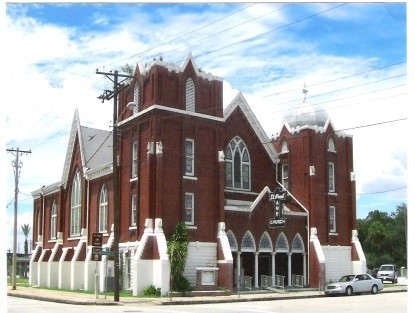Saint Paul’s African Methodist Episcopal Church
Introduction
Text-to-speech Audio
The former St. Paul’s African Methodist Episcopal was constructed between 1906 and 1914 to serve a congregation that was established shortly after the Civil War. Although dwindling membership led the congregation to move from this large building in 2010, the congregation remains the oldest in Tampa's Black community. This structure has been converted to hold offices as well as apartments.
Images
Completed in 1914, the former St. Paul's A.M.E. Church was an important religious and cultural center for the local African-American community. Notable figures such as Paul Robeson and Jesse Jackson delivered speeches here. Dr. Martin Luther King visited in 1961 to discuss civil rights activism in Florida..

Backstory and Context
Text-to-speech Audio
Established in 1870 by Reverend Thomas Warren as Brush Harbor Mission, this congregation built its first church structure in 1872. This church was located on Marion Street and opened as Mount Moriah African Methodist Episcopal Church. Hurricanes destroyed it and the next church within the next two years. In 1875, the third church was built, and the congregation's name was changed to St. Paul's. The congregation grew in the coming years, especially during the mid-1880s when large numbers of people settled in Tampa to work in the railroad and port industries. In 1906, the congregation decided to build a new church (the present one). Construction began in July and took until, it appears, late 1914 to complete.
During the 1950s and 1960s, St. Paul's was the center of civil rights activism in Tampa. Paul Robeson, Jesse Jackson, Supreme Court Justice Thurgood Marshall, and President Bill Clinton have all delivered addresses from St. Paul's pulpit. Dr. Martin Luther King traveled to Tampa in November of 1961, meeting with St. Paul members and leaders of the civil rights movement to discuss their vision for the Civil Rights movement in Florida.
St. Paul's is also important for its association with African American education in Tampa. The congregation provided some of the funding for the Harlem Academy School, which was built next to the church in 1895 after a fire destroyed the previous school. The school was established in 1868 and was the first public school for African American children in Tampa. Classes were first held in the county courthouse before moving to a building (called School No. 2) erected in the early 1870s by the Freedmen's Bureau. The next building, the one destroyed by the fire, was erected in 1889 and named the Harlem Academy. Classes were held in St. Paul's and other churches while the 1895 school was being built. A new brick school was erected in 1912 and it operated until 1864. It was eventually razed.
Sources
"Historic Harlem Academy/School #2." The Historical Marker Database. Accessed November 22, 2023. https://www.hmdb.org/m.asp?m=27707.
Kite-Powell, Rodney. "Steep(l)ed In History: Sacred Heart Catholic Church & St. Paul AME Church." Tampa Magazine. March 17, 2022. https://tampamagazines.com/steepled-in-history.
Nandini Jayakrishna, "Historic Tampa Church Moves." Tampa Bay Times August 30, 2010. https://www.tampabay.com/archive/2010/08/30/historic-tampa-church-moves.
